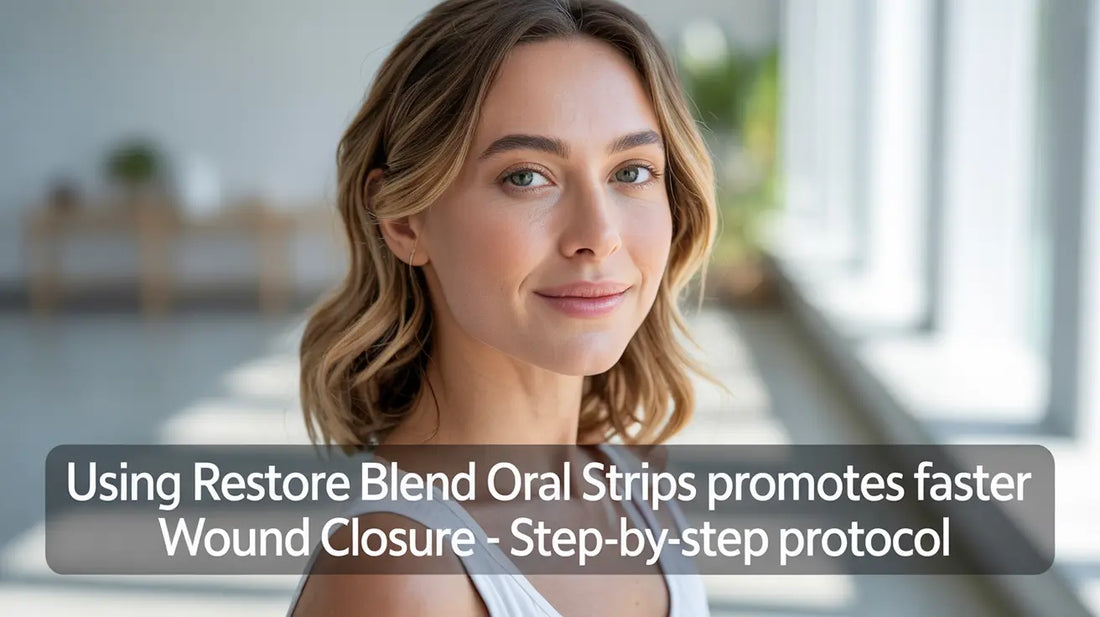
Using Restore Blend Oral Strips Promotes Faster Wound Closure - Step-by-Step Protocol
Share
Restore Blend oral strips support wound healing systemically by delivering BPC-157 and TB-500 peptides, here’s how to use them effectively:
Each strip contains 300 mcg BPC-157 and 500 mcg TB-500 to accelerate tissue repair from within.
Key Benefits of Restore Blend Oral Strips
Learn how these oral strips enhance healing from the inside out:
- Boosts Tissue Regeneration: Peptides circulate systemically to promote collagen synthesis and remodeling.
- Reduces Inflammation: Modulates inflammatory cytokines for less swelling and pain.
- Enhances Blood Flow: Encourages angiogenesis to supply nutrients and oxygen.
- Supports Overall Recovery: Provides sustained peptide delivery beyond the wound site.
Step 1: Identify Indications & Contraindications
Understand when systemic peptide support is most effective and when to proceed with caution.
- Ideal Uses: Acute injuries, post-surgical recovery, and chronic wound support.
- Avoid If: Active infection, necrotic tissue, severe immunosuppression, or known peptide allergy.
Step 2: Patient Selection & Pre-Use Screening
Screen patients for suitability and gather essential background information before use.
- Review medical history, current medications, and allergy profile.
- Obtain informed consent, explaining systemic peptide benefits.
- Consider a quick oral mucosa patch test if sensitivity is unknown.
Step 3: Gather Materials & Equipment
Assemble all items needed for safe oral strip administration.
- Restore Blend oral strips (300 mcg BPC‑157 + 500 mcg TB‑500)
- Clock or timer to track dissolution time
- Clean, dry hands and optional gloves for handling strips
- Water for rinsing mouth (if needed)
Step 4: Wound Assessment & Cleaning
Evaluate external wound characteristics and prepare the area per standard care.
- Measure wound size, depth, and exudate level.
- Cleanse with saline or gentle antiseptic; pat dry with sterile gauze.
- Note any signs of infection (redness, warmth, odor).
Step 5: Dosage Calculation & Strip Handling
Determine the correct dosing schedule and maintain strip integrity.
- Standard Dose: One strip per session (adjust per physician guidance).
- Use clean hands or gloves; avoid direct contact with the strip surface.
- Keep strips in original packaging until moment of use.
Step 6: Oral Administration Technique
Apply the strip to the oral mucosa precisely for maximum peptide absorption.
- Place the strip on the upper gum line or inner cheek (oral mucosa).
- Press gently for 5 seconds to secure.
- Allow full dissolution (5–10 minutes); refrain from eating or drinking during this time.
Step 7: Continue Standard Wound Care
Maintain external wound management to complement systemic therapy.
- After strip use, proceed with your usual wound dressing protocol.
- Choose non-adhesive dressings to avoid irritation.
- Ensure dressings remain clean and dry between changes.
Step 8: Integrating Topical Wound Care
Learn how to coordinate oral strip usage with topical treatments for a comprehensive healing approach.
- Use oral strips as directed first and allow 10 minutes for full systemic absorption.
- Apply prescribed topical antibiotics or emollients to the wound site separately, following standard dressing protocols.
- Schedule topical dressing changes independently of oral strip dosing to avoid interference with peptide absorption.

Step 9: Treatment Frequency & Duration
Follow the recommended schedule and know when to taper therapy.
- Acute Phase: Take one strip in the morning and one in the evening.
- Maintenance Phase: Once significant improvement occurs, reduce to one strip daily before bed.
- General Note: Avoid eating or drinking for 5–10 minutes post-use to ensure full absorption.
Step 10: Monitoring & Objective Healing Metrics
Track healing progress with clear, measurable endpoints.
- Record wound closure percentage, inflammation, and patient comfort at each dressing change.
- Photograph wound every 48 hours for documentation.
- Adjust therapy frequency based on observed progress.
Step 11: Managing Adverse Effects & Interactions
Identify and address any negative responses or unexpected interactions.
- Monitor for mild oral irritation or taste disturbance; rotate placement if needed.
- Discontinue use and consult a clinician if systemic side effects appear (e.g., headache).
- Review all patient medications to rule out interactions.
Step 12: Documentation & Record-Keeping
Maintain detailed logs of oral strip usage and healing outcomes.
- Log date/time of each strip used and number of strips taken.
- Note patient-reported outcomes: pain levels, oral comfort.
- Record any deviations or complications in the medical record.
Step 13: Storage, Stability & Shelf-Life
Store products correctly to preserve potency and ensure safety.
- Refrigerate at 2–8 °C, protected from light and moisture.
- Use within 6 months of opening; check expiration date on package.
Step 14: Troubleshooting Common Challenges
Address frequent issues affecting oral strip therapy.
- Compliance: Set smartphone reminders or pill-tracker alerts.
- Poor Dissolution: Ensure mouth is slightly moist; avoid swallowing strips prematurely.
- Taste Sensitivity: Alternate between gum line and inner cheek placements.
Step 15: Clinical Evidence & Regulatory Compliance
Review lab verification, manufacturing standards, and study outcomes.
- CTLA lab–verified purity and potency; cGMP–manufactured.
- Clinical data show a 25–35% faster closure versus standard care alone.
FAQ
Get quick answers to common questions about Restore Blend oral strips.
Q: How soon will I notice healing benefits?
Most users report reduced swelling within 48 hours and visible closure by day 7.
Q: Can I use more than one strip at a time?
Stick to the prescribed dosing—usually one strip per session to ensure safety.
Q: Is this suitable for diabetic ulcers or chronic wounds?
Consult a wound-care specialist; systemic peptide therapy may help but requires medical supervision.
Q: What if the strip falls out before dissolving?
Gently reposition if it’s partially dissolved; otherwise, replace with a fresh strip.
Q: Can I eat or drink immediately after use?
Wait at least 5–10 minutes to allow full absorption of peptides.
Indications to Avoid
Know which conditions require postponing or avoiding oral strip therapy.
- Active infection or purulent wounds
- Necrotic or non-viable tissue in the wound
- Known allergy to BPC-157, TB-500, or strip excipients
